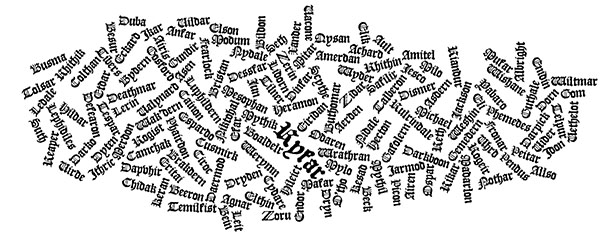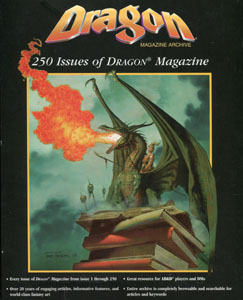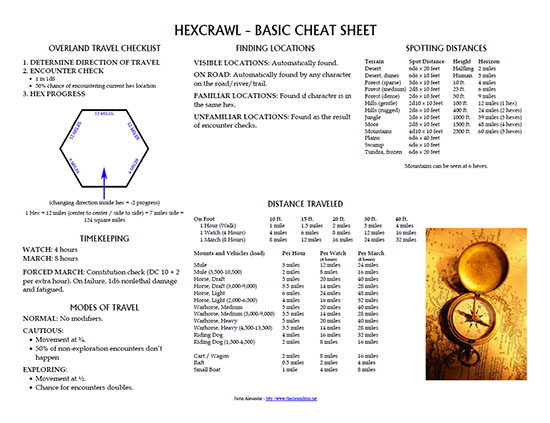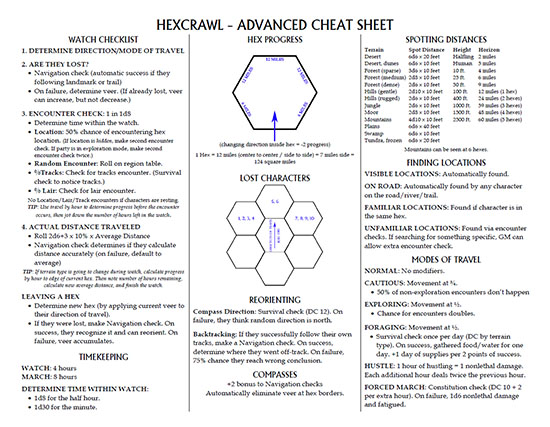
This article originally appeared in Pyramid Magazine on July 23rd, 1999.
When a character is in the process of being created it is a rather magical period of time. The most proficient members of our hobby are able to breathe so much life into their characters that they seem to actually inhabit the bodies of their players while the game is in action.
However, the half-elven archer who is tortured by the fact of his heritage and was torn from his mother and rejected by his father when the truth was first learned — while being an exciting and interesting character to play — is all too easily spoiled by a name such as: “Ron the Archer”. Somehow it just seems to lack an essential ephemeral quality.
An engaging, exciting, entertaining, and original name for characters in a fantasy universe has become essential. “Gregory” dims in comparison to “Fairyleaf” or “Dewdusk”; “Stewart” becomes shallow when held up to names such as “Aldervan” or “Floaic”.
But there are no sources from which to draw these names and I have, more than once, had the character creation process halted by the fact that I cannot find an appropriate name for a character. Even fantasy literature does not aptly serve this purpose, because if you have seen one “Aragorn” you have seen them all.
The task becomes even more daunting for the aspiring Game Master. He must, literally, populate his world with thousands of NPCs and the one bad memory of “Bob the Butcher” will leave a much greater impression upon his players than a hundred characters with interesting and original names will ever do.
This problem is one unique to the gamers of fantasy. If you are playing a campaign on the modern or futuristic scales names such as “Donald” and “Blake” do not appear incongruous with their surroundings, and “Arthur” is a fine name for a historically-based medieval campaign. Fantasy, on the other hand, is a world of primitive wonders that are completely unearthly in their scope and nature. This inspires us to come up with equally unnatural and magical names to the mirror the world in which the individuals who bear these names live their lives. Fantasy worlds are the domains of Fafhrds and Alustriels… somehow it seems the only proper thing to do.
This article strives to alleviate these problems from the backs of fantasy gamers by providing sources you may not have thought to consult, as well as some basic ways to start the creative process when the block occurs.
HISTORICAL TEXTS
Historical texts are an invaluable source for names. Although many are cluttered with more common names such as “John” or “Margaret” you can often caches of treatises which deal in totally foreign names.
J.R.R. Tolkien used historical papers and names extensively. The names of the thirteen dwarves from The Hobbit are lifted verbatim and in order from one of the Icelandic sagas.
Even the common-sounding names from historical papers can often be fancied to one degree or another to produce a usable fantasy name of some sort. For example, while “Thomas” is rather mundane you can easily make it of the female persuasion (“Thomasine”) and end up with a name that is not commonly used.
LEGENDS AND FAIRY TALES
Naturally enough, from this sort of material, you will be able to reap great rewards in terms of names. Although many of these tales employ common names of the time period, it is not hard to find names (usually in the more mystical sections of the story) that will spark your creative skills.
Often you will find good sorts in foreign tales, as names are not typically translated. Therefore you can draw greatly from common names, so long as they are not common to the people with who you are playing.
It is also advised that you avoid well known material. Having the captain of the Lich’s guard named “Neibling” is probably not the best way to come off as witty and an intelligent to your peers; similarly the elven archer who has lost his royal title and is named “Robin” is not going to instill coos of delight at your originality. Therefore avoidance of tales in the ilk of Robin Hood or King Arthur is heartily suggested.
FANTASY FICTION
Although the last names of your peers may seem boring and commonplace, it is more likely because you have become overexposed to them. There are many uncommon last names with a feeling of unearthliness attached to them, and if employed correctly even your local phone book can be applied to naming your NPCs.
If you have a large library of novels and other works it is suggested that you look at the last names of some of the lesser known authors. Names such as “Gillard” and “Amend” strike me as perfect for the use being discussed. Even slightly more earthly names such as “Blish”, or names that seem just slightly unusable, can be changed in various manners (see the Syllables sections below) to suit your purpose.
It is also suggested that you get in the habit of looking at the credit pages of large books. If you look at the front of a TSR book you will get a listing of everyone from the CEO to the artists to the actual writers of the work. A massive collection of names, any one of which may be fascinating for you.
To stress this point again (and I do not believe it can be understressed): Do not use the last names of popular authors. If you add characters such as a fearsome fighter of unparallelled strength known as “Asimov” or a butcher named “Gygax” the popularity of your campaign may be drastically reduced. The author of this article takes no responsibility if this warning is ignored.
COMBINATIONS
If you are in a rush a cut and paste method may best fit your tastes. By this I mean that by a combination of two different sections of text from a work (or two different works) you may be able to come up with something completely original.
For example: Paging through a handy science fiction novel I spot two names I rather like, Bryce and Nicolai. I quickly paste them together and my character becomes known as Nicolai Bryce.
Try to make it compositionally sound; “Richard Andrew” just doesn’t make the cut.
Do not let yourself be limited to just fantasy authors. If you employ this method in combination with the Last Name method above you’ll find great success: modern fictional characters can have exciting last names just as easily as real people. The only thing to remember is our prime directive: No popular works (and thus, in this case, characters). Therefore “Gandalf Bilbo” is probably not the wisest thing to attempt.
GAMING SUPPLEMENTS
Gaming supplements may seem unlikely places from which to draw material from names — especially if you are playing the game in question — but, if done properly, the supplements game companies produce are invaluable assets.
If you are running the campaign on the fly, either because the PCs have taken off in an unexpected direction or you simply had nothing prepared, and you want them to enter a village, but have no name for it my suggestion is to open one of the game worlds produced by game companies. This process works for any locale name, from cities to mountain ranges, so long as you avoid the more popular names which are immediately recognizable.
SUGGESTED
GM: The dust billows up around you as you walk down the dusty road. A rickety old sign off to the side says “Sourlode”; some short figures, probably dwarves, are milling about an old mine entrance about a half mile away.
Player: Wow!
AVOID LIKE THE PLAGUE
GM: Alright, you’re in Waterdeep–
Player: So this campaign is in the Forgotten Realms?
GM: No, I just stole the name.
This method even works effectively for NPCs; so long as you avoid Elminsters and Raistlins you should meet with successful results.
BABY NAME BOOKS
Although the vast majority of the space in these tomes are filled with commonplace names such as “Betsy” and “Frank”; one of my best characters — Darwara — was named from one such book.
It may take a little bit of time to find an appropriate name, but if you are completely out of ideas or simply want to browse for awhile you may uncover simply wonderful and awe-inspiring names that you never would have considered. Render all options fully available to yourself; leave no stones unturned and no doors unopened.
SYLLABLES, METHOD ONE
The modern world as we know it is a mass of written material. Even the radio, a purely sound based invention, will have written characters upon it. At this very instant there is 100% chance that there is written material within your line of sight (since you are reading this I figure this is a pretty safe bet).
Each word in the English language is broken down into syllables — one or more for each word. This also applies to names. If you find a string of syllables and arrange them in an audibly appeasing fashion chances are that you will end up with a name fully usable for a fantasy character.
To exemplify an this procedure: I have an AD&D handbook close at hand. Across the room is a shelf of Star Trek novels. From those five words (Advanced, Dungeons, Dragons, Star, Trek) I can construct the name of “Adarun”. I drew the syllable “ad” from “Advanced”; the syllable “ar” from “Star”; and the syllable “un” from “Dungeon”.
This procedure can be applied to any written material you may have at hand. The name “Procan” is drawn entirely from two words in the previous sentence, considering how many words fill up this magazine there are a nearly infinite number of names you could conceive from the combination of varying syllables throughout.
Considering that there must be some written material at the game table in order for the game to be played, it should not be vastly difficult to come up with names on the fly with this method.
SYLLABLES, METHOD TWO
The first step you must take in applying this method is finding a base word; usually this is the sort of thing you can simply pick out of thin air. From this base word you change syllables incremently to similar sounds, or delete them entirely until you come up with a name which you enjoy. It takes me approximately ten seconds to run through the whole process (on average) in my head.
For example:
Ravenloft
Cavenloft
Cavloft
Covloft
Covlaft
And you have a completely original name that is unlikely (if not impossible) for anyone to trace back to its roots in the word “Ravenloft”.
CONCLUSION
I can only hope that this article finds its way into the hands of at least one Gamemaster who will find some use for it. Who will be able to improve his campaign, reduce the guffaws from his players as NPCs with generic names gain center stage, and add the essential elements to the atmosphere of his campaign that creative and correct naming processes can accomplish.
This article was my first professional sale. In fact, it was almost my first professional sale twice over: I sold it to Shadis Magazine, but it remained unpublished when Shadis went on permanent hiatus in 1998. When it became clear that Shadis wasn’t coming back, I sold it to Pyramid Magazine. (In the interim, however, I had sold a book to Dream Pod 9 that was never published.)
Reading it now, I find myself cringing a lot at how overwritten it is. The core of the advice remains pretty solid, though: The syllabic methods remain my go to solution for cranking out alien/fantastical names. (I will note, however, that I find my younger self’s intolerance of names like “Gregory” and “Thomas” for fantasy characters completely inexplicable.)
Semi-interesting note about the byline here: This article was originally published under the name “Justin Bacon”, which was the same name my RPGNet reviews had been appearing under. (At the time my legal name was “Justin Alexander Bacon”.) Shortly thereafter, however, I decided that I wanted to drop my last name and simply be “Justin Alexander”, so I asked Steven Marsh (the editor of Pyramid) to change it. Thanks to the glorious flexibility of digital publishing, this was easily done. Unfortunately, a few months later Dream Pod 9 screwed up the Jupiter Planet Sourcebook for Jovian Chronicles and published the book (my first book!) under the name “Justin Bacon”. I reluctantly decided to accept the fait accompli and went back to Steven Marsh and asked him to swap my article credit back to “Justin Bacon” with the intention of using it for all my future RPG work. (Later I took a hiatus from the industry and when I came back I decided to reverse course once again and fully embrace the name “Justin Alexander” for all of my work, for better or worse.)

 I think that anyone who spends a fair bit of time hanging out with Shakespeare’s plays ends up accumulating a few choice phrases that will restlessly bounce around the inside of their skulls. I’m not necessarily talking about the big quotes. (Those are pretty much culturally ubiquitous.) What I’m talking about are the snatches of lesser-known verse that just happen to velcro onto your subconscious.
I think that anyone who spends a fair bit of time hanging out with Shakespeare’s plays ends up accumulating a few choice phrases that will restlessly bounce around the inside of their skulls. I’m not necessarily talking about the big quotes. (Those are pretty much culturally ubiquitous.) What I’m talking about are the snatches of lesser-known verse that just happen to velcro onto your subconscious.












